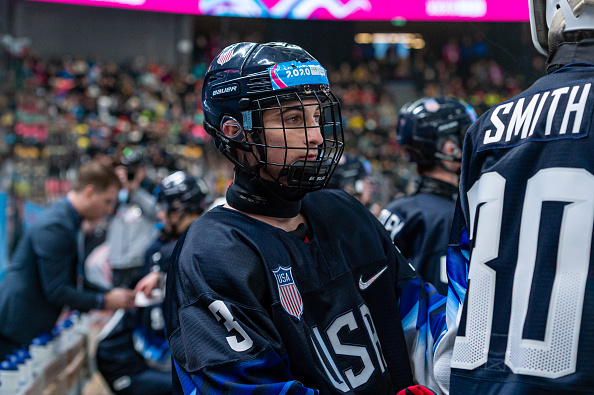Seamus Casey may be the most intriguing draft prospect in this class from the US ranks. He has been ranked all over the place, by all different outlets. He very well could be the first defenseman taken in the draft, or one of the last taken in the first round. But one thing is fairly certain, Casey is a high-upside, first-round talent in the 2022 class.
Seamus Casey is a top-15 talent
Casey, born in Miami on January 8th, 2004, is a right-shot defenseman. Joining the USNTDP team in the 2020-21 season, the 5’10” and 161 pound Casey scored two goals and 18 assists for 20 points in 30 USHL games that year. He followed that up with a goal and 10 assists for 11 points in 14 USHL games thus far. In his entire tenure, thus far, in all USNTDP games, not just USHL games, Casey has scored 13 goals and 47 assists for 60 points in 83 games.
With that production, Casey has been ranked 11th by The Puck Authority and Dobber Prospects, 12th by Elite Prospects and Smaht Scouting, 13th by Recruit Scouting, 17th by McKeen’s Hockey, 20th by FCHockey, 21st by Draft Prospects Hockey, 44th by Bob McKenzie, and 50th by Craig Button. This writer has Casey ranked 10th.
Seamus Casey scouting report
Casey getting ranked as a mid-second round selection by Button and McKenzie is definitely a head-scratcher, considering the other rankings have him top-20 almost exclusively. This writer has him ranked the highest as well, so what makes Casey such a high-end prospect to most?
Seamus Casey’s skating is a strength
Similar to a report on Frank Nazar, one of Casey’s teammates, Casey’s size is a concern and needs to be balanced out by his skating. Luckily for him, it mostly is. Mostly. The biggest concern for Casey is his top-end speed. There are situations where he loses foot races to pucks dumped down the ice. Casey’s straight-line speed needs some improvement moving forward, as when he faces bigger, stronger and faster competition at the next level, he could get exposed. However, he is a very good skater despite the limitations to his speed.
Casey is extremely shifty. His edges are one of the best, if not the best, in the draft class. He is so hard to predict with his movements, as he can stop on a dime, change directions at the snap of your fingers, and his balance makes him difficult to push off the puck in tight situations. From a technical stand-point, he’s very refined. His ankle flexion and knee bend is solid, and his stride extensions are very good. Casey’s acceleration could use some work, but it is a lot less of a concern than his straight-line speed. He has the abilities to win short-area races more often than not against USHL competition.
Offensive abilities
When it comes to his offensive abilities, Casey shines. The edge work touched on above shines through offensively. He has an innate ability to walk the blueline and open passing or shooting lanes extremely efficiently thanks to his foot work. When pressured at the point, he not only has the shifty edges to shake off that pressure, but he also has the stickhandling ability to get past his opponent, consistently.
However, Casey is not very aggressive offensively. He tends to sit back on the blueline and make the smart plays. He makes quick reads and moves the puck fast to open teammates, al over the ice. In three tracked games, Casey attempted 41 passes in the offensive zone, completing 35 of them (92.67% accuracy, ranks second of nine defensemen tracked). Of those passes, just 7.32% were directed at high-danger, while 78.05% were directed to low-danger.
However, when Casey elects to be aggressive with the puck, he can be dangerous. As mentioned, his stickhandling is very good, and he can dance his way deep into the offensive zone. His vision and passing ability is very good, and he reads the opposing defenders really well, to constantly pose a threat. Without the puck, he again is mostly conservative. But when he picks his chances to position himself in a dangerous spot, he does an excellent job finding open areas. Casey could be so much better than he has shown offensively, if he turns up the dials a bit more.
Seamus Casey’s shooting ability
An area that could definitely use some improvement is Casey’s shot. From a distance, Casey does not pose too much of a threat. The accuracy on his shots are not the problem; he manages to get pucks on net through traffic very often, and he keeps thise shots low. However, his shot lacks power. Additionally, he does not shoot very often. He fired 17 shots through those three tracked games, with 10 hitting the net (58.82%). That accuracy ranks third among those nine aforementioned defensemen.
If Casey can improve the power behind his shots, while simultaneously being more aggressive both with and without the puck, he could be an elite offensive presence. However, his ability to read the play and pick his time to jump up in the play is also a valuable asset. It shows his hockey IQ and his ability to keep his defensive responsibility as his main concern. NHL coaches may prefer that aspect.
What do these numbers tell us?
At the end of the day, these numbers all mean Casey is not the most aggressive defenseman with his offensive tendencies. However, it does suggest that, when he decides to make a play, he can be very efficient. He is a smart player, and everything he does is calculated and precise. Casey is the type of defender who won’t make too many mistakes that lead to scoring chances for the other team. He is a high IQ, smart, and efficient defender in the offensive end, with high upside if he decides to be a bit more aggressive.
Seamus Casey’s transitional abilities
Casey may be the most efficient transitional player in this class of defenders. His vision and IQ with the puck on his stick is very clear in the neutral zone. His stickhandling also shines through in transitional situations. Casey is also a very efficient passer through the neutral zone, putting the puck in the right spots to allow for teammates to receive passes in stride, and not have to slow down.
Unfortunately, he does make some concerning decisions when moving the puck from time to time. He forces passes that don’t need to be made more often than one would like. Sometimes, he misses an easy outlet option to gain a defensive zone exit or offensive zone entry. Those lapses in judgement will be something to monitor going forward, certainly.
When it came to exiting the defensive zone, Casey was directly involved in 18 zone exit attempts, successfully clearing 55.55% of them with possession. The average among the nine tracked defensemen sits at 53.62%, putting Casey above the average. As for entering the offensive zone, Casey was involved directly on 21 total attempts, gaining the zone with possession on 71.43% of them. The average among the nine defensemen sits at 48.07%, showing Casey’s dominance in that aspect.
When it comes to carrying the puck out himself in both exits and entries, he sits at 16.67% zone exit carries and 23.81% zone entry carries. The averages for those two stats are 16% and 12%, respectively. This shows that Casey tends to carry the puck himself at a higher clip than most of the nine defensemen tracked.
Seamus Casey’s defensive zone play
Defensively, Casey stands out positively. He is so good at defending the rush, especially. He faced 25 rush attempts directly in the three tracked games, and he successfully prevented an entry on 44% of them (the average is 35.5%). Additionally, he allowed a clean zone entry on just 24% of them, which is below the average of 33%, which is solid. Casey does a very good job of closing gaps and forcing plays to the perimeter. He has a very quick and accurate stick check, which allows him to be one of the better defenders when defending against the rush. Pairing his rush defense with his transitional abilities, he can be a threat for a quick counter attack.
When it comes to having to defend his opponents when they have possession in the zone, Casey does his job well. He doesn’t get caught puck watching or puck chasing much, and he generally does a good job positionally. He holds his own in net-front battles and keeps his head on a swivel to be sure everyone is accounted for in the defensive end. His quick stick and solid work ethic is shown with the way he pressures opponents and keeps them along the perimeter. He reads the play exceptionally well and does an excellent job directing play away from the slot.
What is the potential of Seamus Casey?
Casey has the ability to impact play in all three zones. That is a big development for someone at his age. Being one of the most complete defensemen in this draft. It’s difficult to see why guys like Button and McKenzie have him ranked outside the first-round, outside of concerns that older generation hockey guys have with his size. But it should be time to move past the argument against drafting smaller players, isn’t it?
Have we learned nothing from the successes of Brayden Point, Cale Makar, Torey Krug and so many other “undersized” players? Is Casey a perfect prospect? No. Will his size ultimately have an impact moving forward in his chase to become an NHL player? Of course. But it should not lead to teams passing on him. The talent and the overall well-balanced player he is should convince most teams within the first round to take a flier on him.
As for potential, he strikes this writer as a future number two defender. It is hard to think he will ever be an aggressor in the offensive zone. At least to the point where he becomes a top defender for a team. However, if paired with the right guy, he could be a top pair defender. As for a comparison, he is very similar to Krug, but with less offensive upside and less physicality. He’s smaller like Krug, but he is extremely smart and excellent in transition. If those traits can be developed and translate to the NHL well, Casey could be the steal of the class.






